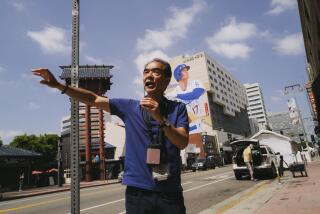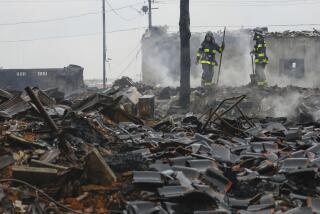Damage to Port Chokes Off Kobe’s Lifeline
KOBE, Japan — The docks are closed, the sea walls of what was once Japan’s busiest international port ripped apart. Black, acrid smoke from an early morning fire still billows out of a Mitsubishi warehouse.
As far as the eye can see, 50,000-pound cargo containers lie tumbled on savagely cracked pavement roads; the giant orange cranes that loaded them on ships from all over the world are idle.
Ever since the Meiji restoration ended three centuries of isolation 127 years ago, Kobe’s port has served as one of Japan’s windows to the world and defined the city’s image as vibrant and cosmopolitan. It has directly led to the town’s famous industries of steel and shipbuilding.
The blue waters of the picturesque port, along with the scenic backdrop of the Rokko mountain range, inspire locals to proudly call their town the “Naples of the Orient.” Now, however, the demolished port stands as a symbol of the city’s shattered identity.
“This is just like after the war,” said Masao Takahata, chief of the Kobe Chamber of Commerce and Industry. “We have to start again from zero.”
The extent to which Japan’s worst postwar disaster has choked off Kobe’s premier economic lifeline can barely be imagined, said Yasuo Nagahisa, port office manager for Mitsubishi’s warehouse.
Every year, more than 11,000 ocean freighters call in Kobe to bring in or take out 170 million tons of cargo, the highest volume in the nation.
Kobe brings in the food, chemicals, machinery and raw materials needed to feed the nation and its mighty export machine. It sends out those exports--textiles, machinery, home electronics and chemical products--via 26 sea routes throughout the world.
*
City officials, aiming to enhance the port and expand its international trade efforts, built two islands, Port and Rokko, in the last decade on reclaimed land equipped with more cargo and container facilities. Thanks to the improvements, ships can come in and out with virtually no wait, and unload as many as 30 containers in one hour--a superior performance that has helped Kobe win more and more business from Europe to Singapore, Nagahisa said.
But now the port is totally disabled, and will probably take at least six months to repair, Nagahisa glumly predicted. The financial loss is devastating, he said--but the damage to the city’s prestige is even worse.
“The damage to the port destroys, at least temporarily, Kobe’s rank and status,” he fretted, “and the more time it takes to rebuild, the more difficult it will be for Kobe to regain its status as a premier port.”
The disaster is the worst and latest blow for a city fighting to keep a proud heritage. For decades, the city of 1.5 million was the area’s regional king, when seafaring activities and heavy industry formed the backbone of Japan’s economy. Shipbuilding gave rise to Kobe Steel and Kawasaki Steel, two of the town’s most famous companies. A thriving pearl industry also took root.
Kobe’s long history of openness to foreigners is also central to the town’s identity. The Meiji government’s designation of Kobe as an official enclave for international trade and foreign residents prompted the United States and other nations to place consulates here at the turn of the century, boosting the town’s status.
Indeed, one of the town’s premier tourist attractions is its historical foreign-style homes--still called by the quaint term ijinkan , literally “different peoples’ homes.”
They include such architectural treasures as the Thomas Residence, a two-story, steepled structure topped by a rooster weather vane, built by a German trader in 1910. The home represents the town’s only remaining example of an old foreign home built with red brick.
The residence--along with most of the other historical structures in Kobe’s fashionable Kitano district of winding hills and million-dollar homes overlooking Osaka Bay--appear to have emerged unscathed.
The historical structure that seemed to have sustained the most damage was the Hollywood Starway, a home transformed in 1985 into a museum of 1940s Hollywood posters and movie-making paraphernalia. Black-and-white photos of Marilyn Monroe and Audrey Hepburn peeked out from shattered windows; concrete lay tumbled around the pink Corvair convertible and cameras at the entrance to the home.
The city still hosts a thriving foreign community of 84 nationalities, nearly 3% of the population. Chinese and Koreans are the biggest groups, but Americans rank third with 1,300 residents. A total of 8,000 Americans are said to live in the greater Western Japan region known as Kansai.
Many of the Americans in Kobe are missionaries, corporate families, English teachers and students--but the quake appears to have scattered some of them.
Procter & Gamble, Kobe’s largest U.S. company, evacuated most of its employees Thursday to Osaka and Hong Kong after the quake damaged the apartment building housing many of them. Others fled to places where they could find hot showers and warm food.
*
Alexander Hamwell, a recent graduate from USC who came to Japan in 1992 to teach English and study Buddhism, said he was leaving for Osaka. Compared to the Los Angeles earthquake response, where the community quickly mobilized aid efforts, Hamwell said the Japanese response was disappointing.
“They’re not setting up command posts and communication links to give people comfort and make them feel at ease,” he said. “There is no communication from one neighbor to another. I had to get chairs for people to sit on. Old people were on the verge of heart attacks, and these young kids were smoking cigarettes in leather jackets and giggling.”
But Ken Logan, a Berkeley native who recently retired after 23 years as a University of California librarian, said he was staying in Kobe to help out as much as he could. He moved here in April to work as a librarian in the town’s famous international school, the Canadian Academy, and said he was impressed by the Japanese people’s patience, order and calm as they waited in long lines for water and food deliveries without complaining.
“I would much rather be here in a disaster than in the United States,” Logan said.
So far, he said, Kobe had lived up to its reputation as a town of uncommon openness to foreigners.
“I don’t feel I’m being stared at here because I look different, and when I stand around looking vacant, I have people come up to me and ask if I have problems,” he said. “Kobe has a history of foreigners dating back 150 years, and I think the people have developed an attitude that allows for our idiosyncrasies.”
Still, the American population here is said to be dwindling as the yen’s appreciation has made it increasingly expensive to live in Japan. A major blow to Kobe was the closure of the U.S. Consulate in 1987. Pressed to choose between keeping an office in either Osaka or Kobe, the U.S. government selected Osaka.
Now, city spokesman Manabu Shinya said, Kobe is fighting to keep from becoming a mere bedroom community for business executives based in Osaka and the students and scholars of traditional arts and culture in Kyoto.
As Kobe’s key heavy industries lose their competitiveness, the city is struggling to develop new businesses that will keep a strong economic base. Fashion is one; international conventions is another.
But the quake stymies those hopes as well, said the chamber’s Takahata, because luring international conventions relies so heavily on a town’s image.
Kobe is now saddled with the indelible images broadcast around the world of rows of homes in rubble, raging fires, thousands of homeless evacuees, paralyzed traffic and collapsed freeways.
Kobe official Shinya, however, refuses to dwell on how badly the quake has set back the city.
“It’s a great loss, of course, but what we want to show is that we are bright, determined and doing our best,” he said.
Researcher Chiaki Kitada of The Times’ Tokyo Bureau contributed to this report.
* RELATED STORIES: A10, A11
More to Read
Sign up for Essential California
The most important California stories and recommendations in your inbox every morning.
You may occasionally receive promotional content from the Los Angeles Times.











